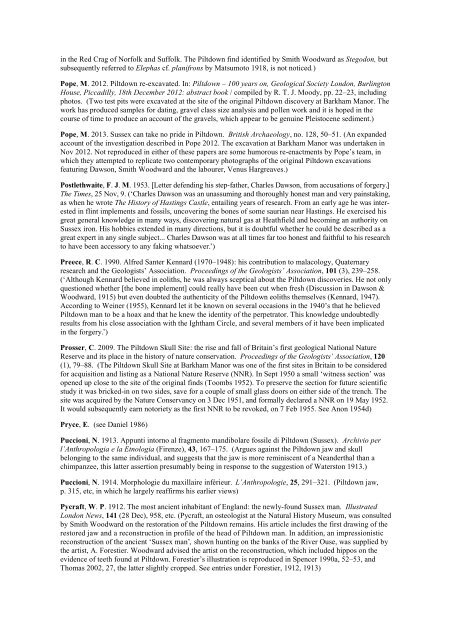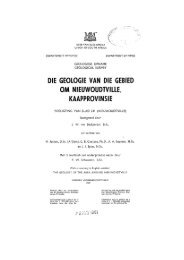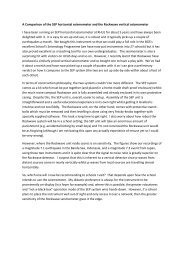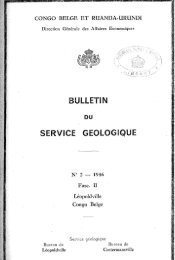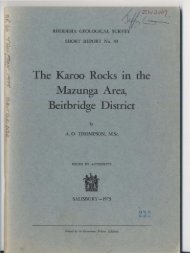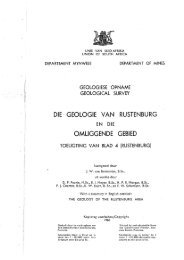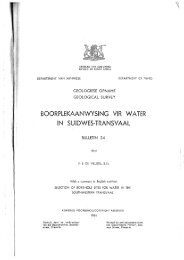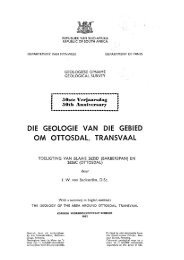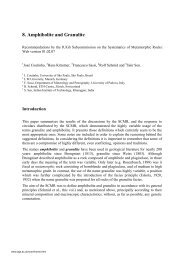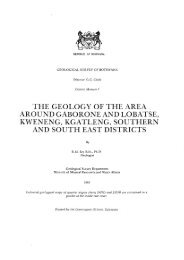Bibliography - British Geological Survey
Bibliography - British Geological Survey
Bibliography - British Geological Survey
You also want an ePaper? Increase the reach of your titles
YUMPU automatically turns print PDFs into web optimized ePapers that Google loves.
in the Red Crag of Norfolk and Suffolk. The Piltdown find identified by Smith Woodward as Stegodon, but<br />
subsequently referred to Elephas cf. planifrons by Matsumoto 1918, is not noticed.)<br />
Pope, M. 2012. Piltdown re-excavated. In: Piltdown – 100 years on, <strong>Geological</strong> Society London, Burlington<br />
House, Piccadilly, 18th December 2012: abstract book / compiled by R. T. J. Moody, pp. 22–23, including<br />
photos. (Two test pits were excavated at the site of the original Piltdown discovery at Barkham Manor. The<br />
work has produced samples for dating, gravel class size analysis and pollen work and it is hoped in the<br />
course of time to produce an account of the gravels, which appear to be genuine Pleistocene sediment.)<br />
Pope, M. 2013. Sussex can take no pride in Piltdown. <strong>British</strong> Archaeology, no. 128, 50–51. (An expanded<br />
account of the investigation described in Pope 2012. The excavation at Barkham Manor was undertaken in<br />
Nov 2012. Not reproduced in either of these papers are some humorous re-enactments by Pope’s team, in<br />
which they attempted to replicate two contemporary photographs of the original Piltdown excavations<br />
featuring Dawson, Smith Woodward and the labourer, Venus Hargreaves.)<br />
Postlethwaite, F. J. M. 1953. [Letter defending his step-father, Charles Dawson, from accusations of forgery.]<br />
The Times, 25 Nov, 9. (‘Charles Dawson was an unassuming and thoroughly honest man and very painstaking,<br />
as when he wrote The History of Hastings Castle, entailing years of research. From an early age he was interested<br />
in flint implements and fossils, uncovering the bones of some saurian near Hastings. He exercised his<br />
great general knowledge in many ways, discovering natural gas at Heathfield and becoming an authority on<br />
Sussex iron. His hobbies extended in many directions, but it is doubtful whether he could be described as a<br />
great expert in any single subject... Charles Dawson was at all times far too honest and faithful to his research<br />
to have been accessory to any faking whatsoever.’)<br />
Preece, R. C. 1990. Alfred Santer Kennard (1970–1948): his contribution to malacology, Quaternary<br />
research and the Geologists’ Association. Proceedings of the Geologists’ Association, 101 (3), 239–258.<br />
(‘Although Kennard believed in eoliths, he was always sceptical about the Piltdown discoveries. He not only<br />
questioned whether [the bone implement] could really have been cut when fresh (Discussion in Dawson &<br />
Woodward, 1915) but even doubted the authenticity of the Piltdown eoliths themselves (Kennard, 1947).<br />
According to Weiner (1955), Kennard let it be known on several occasions in the 1940’s that he believed<br />
Piltdown man to be a hoax and that he knew the identity of the perpetrator. This knowledge undoubtedly<br />
results from his close association with the Ightham Circle, and several members of it have been implicated<br />
in the forgery.’)<br />
Prosser, C. 2009. The Piltdown Skull Site: the rise and fall of Britain’s first geological National Nature<br />
Reserve and its place in the history of nature conservation. Proceedings of the Geologists’ Association, 120<br />
(1), 79–88. (The Piltdown Skull Site at Barkham Manor was one of the first sites in Britain to be considered<br />
for acquisition and listing as a National Nature Reserve (NNR). In Sept 1950 a small ‘witness section’ was<br />
opened up close to the site of the original finds (Toombs 1952). To preserve the section for future scientific<br />
study it was bricked-in on two sides, save for a couple of small glass doors on either side of the trench. The<br />
site was acquired by the Nature Conservancy on 3 Dec 1951, and formally declared a NNR on 19 May 1952.<br />
It would subsequently earn notoriety as the first NNR to be revoked, on 7 Feb 1955. See Anon 1954d)<br />
Pryce, E. (see Daniel 1986)<br />
Puccioni, N. 1913. Appunti intorno al fragmento mandibolare fossile di Piltdown (Sussex). Archivio per<br />
l’Anthropologia e la Etnologia (Firenze), 43, 167‒175. (Argues against the Piltdown jaw and skull<br />
belonging to the same individual, and suggests that the jaw is more reminiscent of a Neanderthal than a<br />
chimpanzee, this latter assertion presumably being in response to the suggestion of Waterston 1913.)<br />
Puccioni, N. 1914. Morphologie du maxillaire inférieur. L’Anthropologie, 25, 291‒321. (Piltdown jaw,<br />
p. 315, etc, in which he largely reaffirms his earlier views)<br />
Pycraft, W. P. 1912. The most ancient inhabitant of England: the newly-found Sussex man. Illustrated<br />
London News, 141 (28 Dec), 958, etc. (Pycraft, an osteologist at the Natural History Museum, was consulted<br />
by Smith Woodward on the restoration of the Piltdown remains. His article includes the first drawing of the<br />
restored jaw and a reconstruction in profile of the head of Piltdown man. In addition, an impressionistic<br />
reconstruction of the ancient ‘Sussex man’, shown hunting on the banks of the River Ouse, was supplied by<br />
the artist, A. Forestier. Woodward advised the artist on the reconstruction, which included hippos on the<br />
evidence of teeth found at Piltdown. Forestier’s illustration is reproduced in Spencer 1990a, 52–53, and<br />
Thomas 2002, 27, the latter slightly cropped. See entries under Forestier, 1912, 1913)


